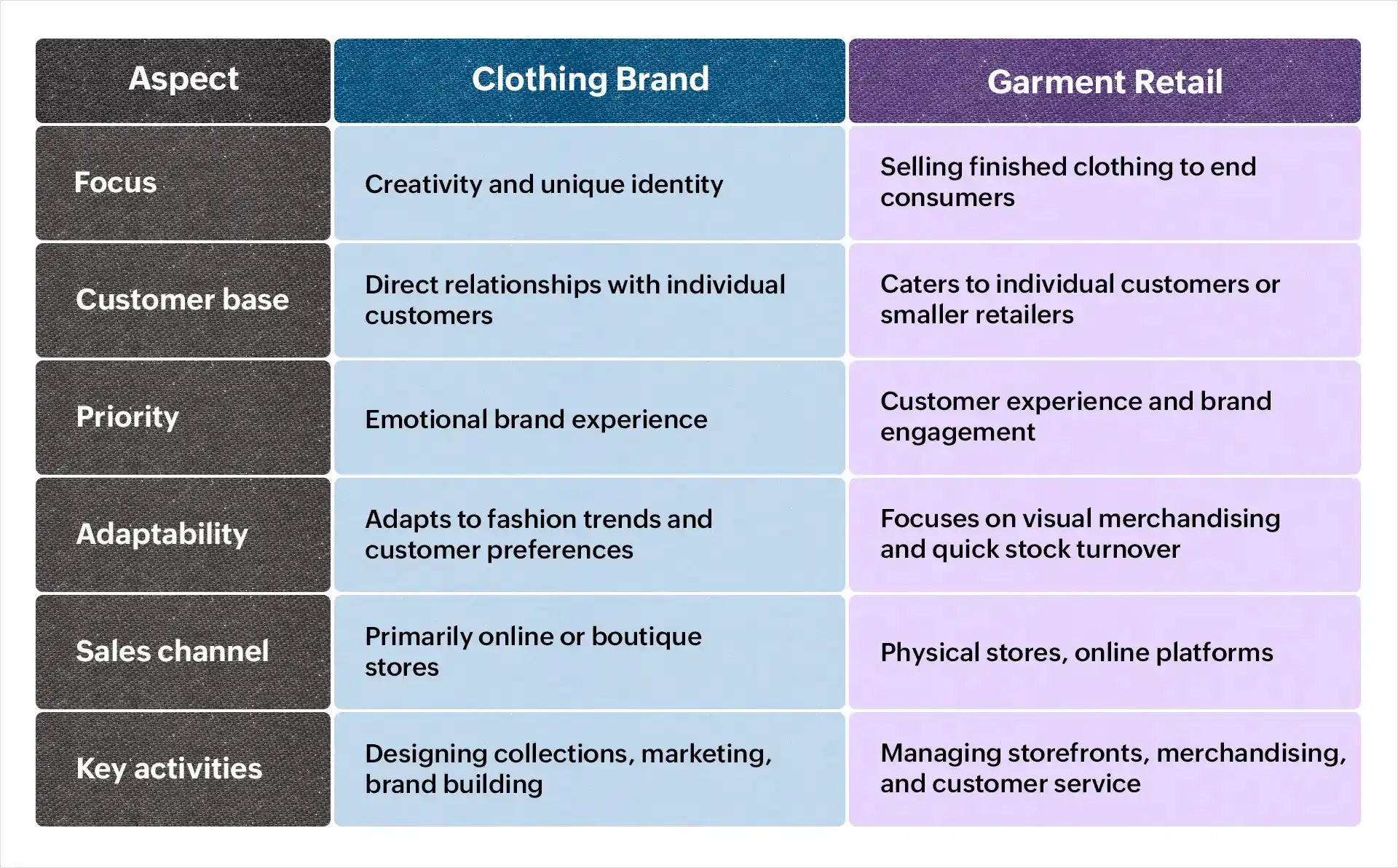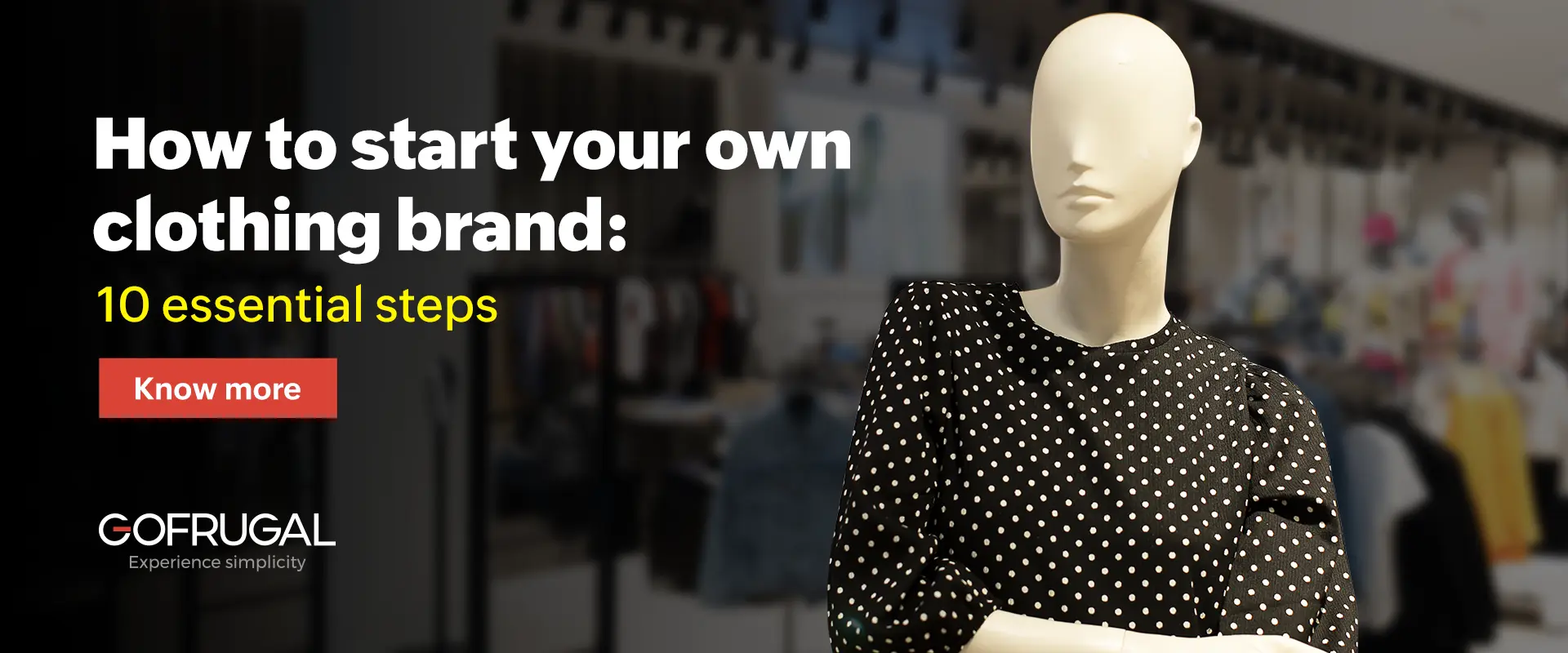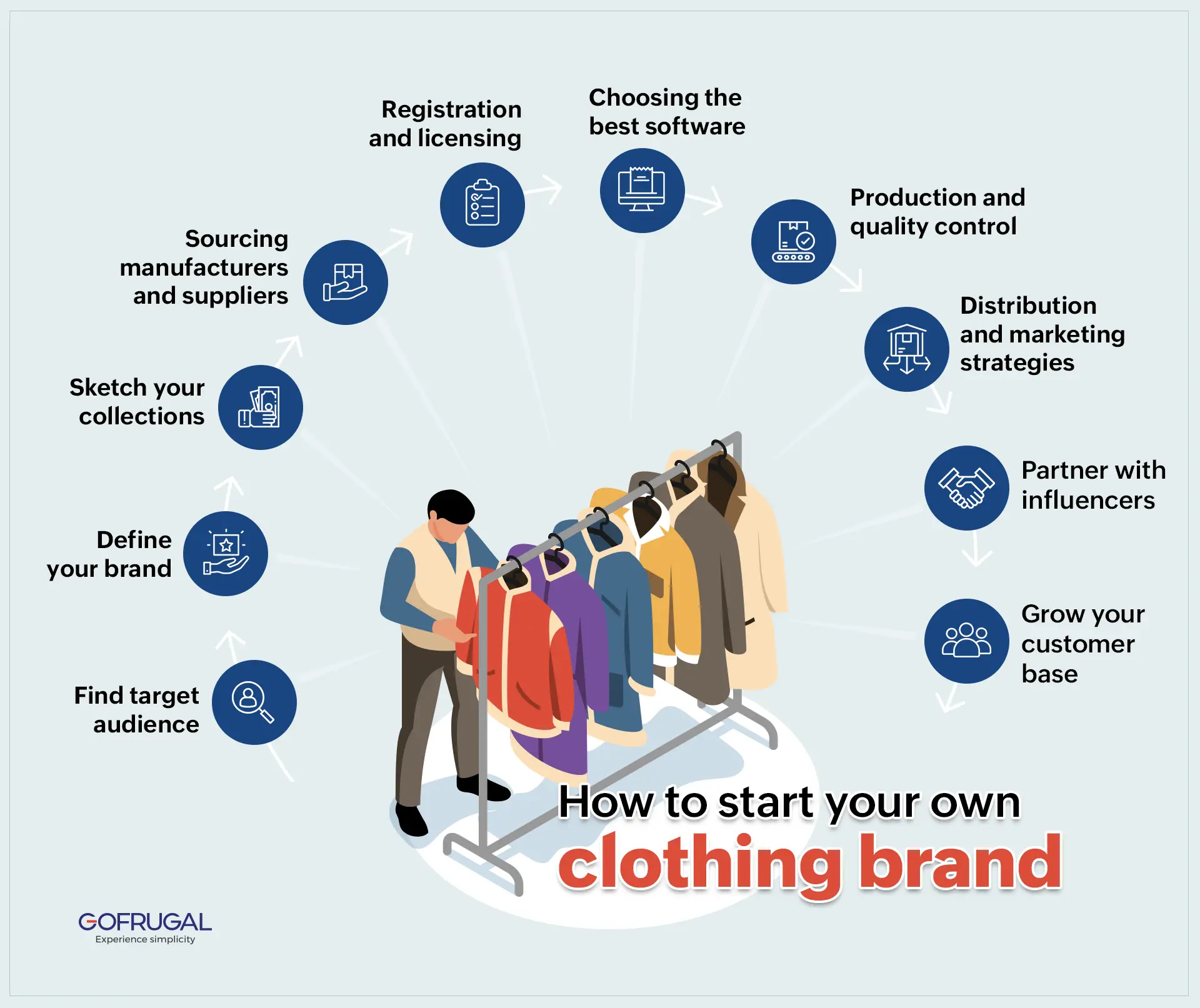Key takeaways:
- Understand the key differences between clothing brand and garment business to position your business correctly.
- Know about creating a business plan, registration and licensing, setting a competitive price and the importance of sketching your collections.
- Implement ERP tools like Gofrugal to streamline operations, manage inventory, and track sales efficiently for business growth.
The rise of independent clothing brands has transformed the fashion industry. In recent years, more people have embraced the idea of launching their own brands, driven by social media, ecommerce platforms, and a growing desire for unique, personalized fashion. Whether it’s sustainable streetwear or high-end luxury collections, today’s consumers want more than just clothes—they want stories, values, and brands they can connect with.
If you're wondering how to start your own clothing brand, now is the perfect time to tap into this trend. The barrier to market entry has lowered, thanks to digital tools, online marketplaces, and global access to manufacturers. This guide will walk you through how to start a clothing business, including everything from defining your niche to launching your first collection, whether from home or a larger physical setup.
Contents
- Differences between a clothing brand and a garment business
- Challenges and solutions in clothing businesses
- How to start a clothing brand
- How Gofrugal can help your clothing business
Differences between a clothing brand and a garment business
When learning how to start a clothing brand, it’s important to understand the difference between a clothing brand and a garment business.

Challenges and solutions in clothing businesses
Inventory management
- Challenge: Managing stock, especially with different sizes, colours, and seasonal trends, can lead to overstocking or stockouts.
- Solution: Use inventory management software to track stock in real-time, analyze sales patterns, and optimize reordering.
High competition
- Challenge: The fashion industry is highly competitive, making it difficult to stand out.
- Solution: Focus on a niche, build a strong brand identity, and offer unique designs or sustainable practices to differentiate yourself.
Changing trends
- Challenge: Fashion trends change quickly, and staying updated can be tough.
- Solution: Conduct regular market research and engage with customers through social media to stay on top of trends.
Sourcing quality materials
- Challenge: Finding reliable suppliers and high-quality materials can be difficult, leading to production delays.
- Solution: Build strong relationships with suppliers, request samples, and always have a backup supplier.
Cash flow management
- Challenge: Managing cash flow, especially with large upfront costs for production, can strain finances.
- Solution: Plan budgets carefully, negotiate better payment terms with suppliers, and keep a close eye on expenses.
Customer retention
- Challenge: Retaining customers in a crowded market is difficult.
- Solution: Create loyalty programs, offer personalized recommendations, and maintain strong communication through emails, WhatsApp campaigns, and social media.
How to start a clothing brand
Step 1: Finding your niche and defining your brand
Before launching, it's crucial to define your brand’s unique identity.
Identify your target audience: When wondering how to start a clothing business, the first step is to identify your target audience. Who are you designing for? Whether it’s luxury fashion, streetwear, or sustainable apparel, your niche defines your brand’s direction. Understanding your target market will help you align your products, marketing, and overall brand image.
Develop your brand identity: Your brand identity is the foundation of your clothing line. This includes your brand story, logo, tone of voice, and overall values. Consumers today want to connect with brands that share their values, so consider what message you want your brand to convey.
Step 2: Designing your collection
Designing your first collection is one of the most exciting parts of starting a clothing brand.
Sketch your designs: Start by sketching out your clothing ideas. Whether it’s using traditional hand-drawing techniques or digital tools like Adobe Illustrator, the goal is to visualize your collection.
Choosing fabrics and materials: Quality is key to building a long-term customer base. Choose materials that align with your brand values. For example, if you’re creating a sustainable brand, you may opt for organic cotton or recycled fabrics.
Creating tech packs: Tech packs are detailed documents that outline every aspect of your designs for manufacturers. They include specifications like fabric types, measurements, stitching details, and any other important notes that ensure your vision is brought to life accurately.
Step 3: Sourcing manufacturers and suppliers
Finding the right manufacturer is essential for quality control and timely production.
Finding manufacturers: You can source manufacturers locally or internationally. Even fashion trade shows can help you find reliable partners. Ensure you vet them by requesting samples and checking reviews.
Request samples: Before placing a large order, always request a sample to verify the quality of their work. This step is crucial to avoid costly mistakes later.
Negotiate pricing: Manufacturing costs vary depending on location and order size. Negotiate minimum order quantities (MOQs), pricing, and production timelines to keep within your brand’s budget.
Step 4: Registration and licensing for your clothing brand
Business registration
Before officially starting your clothing brand, you need to register it as a legal entity. The type of registration depends on the country and the structure of your business. Common options include a sole proprietorship, a limited liability company, and a corporation.
- Sole proprietorship: A simple and inexpensive structure where the owner and business are legally the same. However, this offers limited protection for personal assets.
- Limited Liability Company (LLC): A popular option for small businesses, an LLC offers liability protection, meaning your personal assets are separate from your business liabilities.
- Corporation: Suitable for larger businesses, a corporation offers the most liability protection but comes with more regulations and tax requirements.
Registering your business ensures you operate legally, gain credibility with customers and suppliers, and open a business bank account to manage finances efficiently.
Obtaining a Tax ID (Employer Identification Number - EIN)
Once registered, you will need a Tax Identification Number (TIN) or Employer Identification Number (EIN) for tax reporting. This number is used to identify your business when filing taxes and helps when hiring employees or opening a business bank account. In some countries, this step is necessary to register for sales tax if you plan to sell physical goods.
Trademarks
To protect your brand’s identity, you should apply for a trademark on your brand name, logo, and any unique designs or slogans that distinguish your clothing line. A trademark ensures no other business can legally use or copy your branding elements.
How to apply for a trademark:
- Search for existing trademarks to ensure your name or logo isn’t already in use.
- Apply through your country’s trademark office.
- Provide detailed information about your brand and its usage, including logos, fonts, and slogans.
- Once approved, your trademark is protected legally, and you can take action against any brand infringement.
Licensing requirements
Before selling, you must secure the appropriate licenses and permits based on your location and type of business. Common licenses include:
- Business license - Required in most regions to operate legally, it’s a general permit that authorizes your business to function within a certain jurisdiction.
- Sales tax permit - If you plan to sell physical products, especially in multiple states or countries, you may need a sales tax permit. This allows you to collect and remit sales tax to the appropriate authorities.
- Home occupation permit - If you're starting a small clothing business from home, check if your local government requires a home occupation permit to operate legally from your residence.
Step 5: Choosing the best software for a clothing brand
When figuring out how to start a clothing business, having the right tools is essential.
Design and project management tools:To bring your clothing brand’s ideas to life, you’ll need design software for creating detailed designs and tech packs for manufacturers. Project management tools are essential for tracking production timelines, managing revisions, and organizing tasks. These tools streamline your workflow, ensuring smooth coordination from design to final product launch.
E-commerce platforms: For your online store, it's essential to choose a robust platform that supports direct-to-consumer (DTC) sales and ensures a smooth shopping experience for your customers.
Inventory management and accounting:With inventory and accounting tools, you can manage your inventory, track orders, handle sales, and streamline accounting processes to ease business operations.
Own clothing app: If you're looking to launch your own clothing app, look for tools that can help you create a branded app for seamless customer orders and engagement.
Step 6: Setting up production and quality control
Once your designs are ready, it’s time to place your first order with the manufacturer. Finalize the production plan by determining quantities, setting timelines, and negotiating pricing to align with your budget and goals.
Quality control
Establish a thorough quality control process to inspect samples and set product standards. This ensures each item meets your expectations before they're sent to customers to help maintain the brand's reputation.
Supplier relationships
Build strong, reliable relationships with your suppliers through clear communication and trust. This ensures smooth production processes, timely deliveries, and long-term success for your clothing brand.
Step 7: Distribution strategies for your clothing brand
Once you’ve figured out how to start your own clothing brand, focus on selling.
Direct-to-Consumer (DTC): Sell directly to customers through your website or social media platforms, cutting out middlemen and building a personal connection with your audience.
Wholesale: Partner with retailers or boutiques to sell your clothing in physical stores.
Online marketplaces: Platforms like Amazon, Flipkart, Myntra, and the like offer a wide reach and immediate customer base.
Pop-up shops and events: Launch temporary stores or participate in fashion events to build local brand awareness.
Step 8: Tailor marketing strategies
Marketing is critical to growing your brand in a crowded market. Try different avenues or a combination of ones to see what drives the most interest.
Social media marketing: Use social media to build a community around your brand. Share behind-the-scenes content, engage with your audience, and run promotions.
Influencer collaborations: Partner with fashion influencers who can showcase your products to their followers and help build credibility.
Paid advertising: Run targeted ads on Facebook, Instagram, and Google to reach your ideal audience and drive traffic to your website.
Step 9: Launching your brand
Before your launch, create excitement by sharing teasers and offering exclusive products or early access to loyal followers. Consider partnering with influencers to reach a wider audience and build credibility. Make sure your website is user-friendly, with a smooth checkout process and secure payment options. Fast and reliable shipping is key to leaving a good first impression. Together, these elements will help you attract and retain early customers.
Step 10: Post-launch: Growing your customer base
After launching, gather customer feedback through reviews and surveys to improve your products and services. Keep your audience engaged by launching new product lines or seasonal collections. Expand your reach with international shipping or by entering new markets. Use personalized WhatsApp and email campaigns to retain customers by sending targeted messages and exclusive offers. Regular communication and marketing efforts will help grow and maintain your customer base. Always use feedback to continuously enhance the customer experience.
How Gofrugal can help your clothing business
Starting and running a clothing brand is easier with the right tools. Here's how Gofrugal can help you.
- Inventory management: With the GoSure app, keep track of inventory daily with ease. Use age-based tracking to set prices for older items to help you sell them faster.
- Real-time sales tracking: With WhatsNow, quickly see which clothes are selling best so you know what to order and understand trends to plan purchases.
- Easy checkout: Manage in-store and online sales from one system. It offers multiple payment integrations for smoother checkouts.
- Customer rewards: Create special loyalty programs to reward customers with offers and discounts.
- Salesperson commission management: Using slab-wise salesperson commission management, set up bonuses for your sales team based on how much they sell to keep them motivated.
- Matrix item management: Easily track product variations like sizes, colours, and styles to simplify stock management.
- Reports and accounting: With customizable dashboards, access detailed reports on sales, expenses, and profits while efficiently managing finances with built-in accounting tools.
Starting a clothing brand is an exciting journey filled with creative opportunities and growth potential. From defining your brand identity to managing production, marketing, and sales, each step requires careful planning and the right tools to ensure success. As you move forward, remember that consistency in quality, building strong customer relationships, and staying adaptable to market trends will help your brand thrive.
To simplify and streamline your operations, Gofrugal offers comprehensive solutions tailored for clothing businesses. Whether it's managing inventory, tracking sales, or launching your own app, Gofrugal has the tools to support your growth. Take the next step and explore how Gofrugal can help you build a successful clothing brand.



